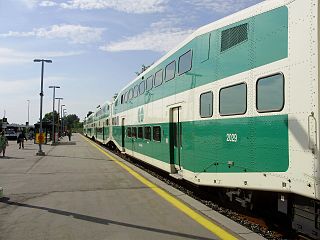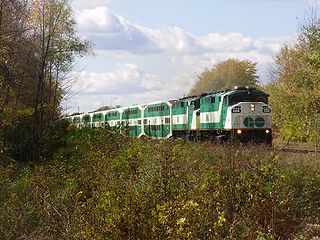Related Research Articles

GO Transit is a regional public transit system serving the Greater Golden Horseshoe region of Ontario, Canada. With its hub at Union Station in Toronto, GO Transit's green-and-white trains and buses serve a population of more than seven million across an area over 11,000 square kilometres (4,200 sq mi) stretching from London in the west to Peterborough in the east, and from Barrie in the north to Niagara Falls in the south. In 2022, the system had a ridership of 35,234,400. GO Transit operates diesel-powered double-decker trains and coach buses, on routes that connect with all local and some long-distance inter-city transit services in its service area.

Union Station is a major railway station and intermodal transportation hub in Toronto, Ontario, Canada. It is located on Front Street West, on the south side of the block bounded by Bay Street and York Street in downtown Toronto. The municipal government of Toronto owns the station building while the provincial transit agency Metrolinx owns the train shed and trackage. Union Station has been a National Historic Site of Canada since 1975, and a Heritage Railway Station since 1989. It is operated by the Toronto Terminals Railway, a joint venture of the Canadian National Railway and Canadian Pacific Railway that directs and controls train movement along the Union Station Rail Corridor, the largest and busiest rail corridor in Canada.

The Toronto subway is a rapid transit system serving Toronto and the neighbouring city of Vaughan in Ontario, Canada, operated by the Toronto Transit Commission (TTC). As of September 2023, the subway system is a rail network consisting of three heavy-capacity rail lines operating predominantly underground. As of December 2022, three new lines are under construction: two light rail lines and one light metro line.

Lakeshore West is one of the seven train lines of the GO Transit system in the Greater Toronto Area, Ontario, Canada. It extends from Union Station in Toronto to Hamilton, along the shore of Lake Ontario. Some train trips extend past Hamilton to St. Catharines and Niagara Falls.

Kitchener is one of the seven train lines of the GO Transit system in the Greater Toronto Area, Ontario, Canada. It extends westward from Union Station in Toronto to Kitchener, though most trains originate and terminate in Brampton in off-peak hours. A two-year pilot project which began in October 2021 extends the line west to London, Ontario.

Barrie is one of the seven train lines of the GO Transit system in the Greater Toronto Area, Ontario, Canada. It extends from Union Station in Toronto in a generally northward direction to Barrie, and includes ten stations along its 101.4 kilometres (63.0 mi) route. From 1982 to 1990 and again from 1993 to 2007, it was known as the Bradford line, named after its former terminus at Bradford GO Station until the opening of Barrie South GO Station.

Richmond Hill is one of the seven train lines of the GO Transit system in the Greater Toronto Area, Ontario, Canada. It operates between Union Station in Toronto to Bloomington GO Station in the north in Richmond Hill. Trains on the line operate only during weekday peak hours, while off-peak weekday times are served by the GO bus route 61.

Lakeshore East is one of the seven commuter rail lines of GO Transit in the Greater Toronto Area, Ontario, Canada. It extends from Union Station in Toronto to Oshawa GO in Durham Region. Buses from Oshawa connect to communities further east in Newcastle, Bowmanville and Peterborough.

Bloor GO Station is a railway station on GO Transit's Kitchener line and Union Pearson Express rail services, located in Toronto, Ontario, on Bloor Street east of Dundas Street West. It is near Dundas West station on the TTC's Line 2 Bloor–Danforth, but is not directly connected to it.

The Union Pearson Express is an airport rail link connecting Union Station in Downtown Toronto to Toronto Pearson International Airport. The UP Express began operation on 6 June 2015, in time for the 2015 Pan American Games. The UP Express travels between Union and Pearson in 25 minutes departing every 15 minutes, seven days a week. At the launch announcement, it was stated that the UP Express was projected to carry 2.35 million passengers annually and eliminate approximately 1.2 million car trips in the first year.

Durham College Oshawa GO station is a station for commuter rail, passenger rail and regional bus services in Oshawa, Ontario, Canada. It is the terminal station for the Lakeshore East line of GO Transit and serves Via Rail's Corridor service, which travels from Toronto to both Ottawa and Montreal. The bus terminal is served by bus routes of GO Transit and Durham Region Transit.

Metrolinx is a Crown agency of the Government of Ontario that manages and integrates road and public transport in the Greater Toronto and Hamilton Area (GTHA), which comprises much of Ontario's Golden Horseshoe region. Headquartered at Union Station in Toronto, the agency was created as the Greater Toronto Transportation Authority on June 22, 2006. The agency adopted its present name as a brand name in 2007 and eventually as the legal name in 2009.

Several plans have been proposed for high-speed rail in Canada, the only G7 country that does not have any high-speed rail. In the press and popular discussion, there have been two routes frequently proposed as suitable for a high-speed rail corridor: Edmonton to Calgary via Red Deer and Windsor to Quebec City via London, Kitchener-Waterloo, Toronto, Ottawa and Montreal.

The Quebec City–Windsor Corridor, also known as simply the Corridor, is a Via Rail passenger train service in the Canadian provinces of Quebec and Ontario. The Corridor service area has the heaviest passenger train frequency in Canada and contributes 67% of Via's revenue.

Line 6 Finch West, also known as the Finch West LRT, is a light rail line under construction in Toronto, Ontario, Canada, to be operated by the Toronto Transit Commission. The 10.3-kilometre (6.4 mi), 18-stop line is to extend from Finch West station on Line 1 Yonge–University to the North Campus of Humber College in Etobicoke. The line will operate in a dedicated above-ground right-of-way, much of it within Finch Avenue, segregated from street traffic. The line will use transit signal priority and standard gauge rather than the broad Toronto gauge. The line is forecast to carry about 14.6 million rides a year or 40,000 a day by 2031 and will replace the 36 Finch West bus route, which is one of the three busiest bus routes in Toronto. The line is expected to open within the first half of 2024, with an estimated cost of CA$2.5 billion.

The A-Line is a proposed rapid transit line running along James Street in downtown and Upper James Street on the escarpment in Hamilton, Ontario. It is part of Hamilton's proposed BLAST network, involving four other rapid transit corridors. It is identified by Metrolinx in its regional transportation plan The Big Move as a project to be completed by 2023. The route is currently served by Hamilton Street Railway's Route 20 A-Line Express bus.
The Big Move is a regional transportation plan (RTP) published in 2008 and consisting of 62 rapid transit projects to be implemented across the Greater Toronto and Hamilton Area (GTHA). These rapid transit projects are intended to form a seamlessly integrated regional rapid transit network, which is the first priority action in the regional transportation plan. These projects form two long-term templates with 15 and 25 year horizons. These templates outline broad projects; specific details about technology, alignment, stations and service levels for each project are subsequently determined though a cost–benefit analysis or an environmental assessment process.

GO Expansion, previously known as GO Regional Express Rail (RER), is a project to improve GO Transit train service by adding all-day, two-way service to the inner portions of the Barrie line, Kitchener line and the Stouffville line, and by increasing frequency of train service on various lines to every 15 minutes or better on five of the corridors. This would be achieved with the electrification of at least part of the Lakeshore East line, Lakeshore West line, Barrie line, Kitchener line and Stouffville line. GO Expansion is one of the Big Move rapid transit projects.

GO Transit rail services are provided throughout the Greater Toronto and Hamilton Area (GTHA) and the Greater Golden Horseshoe. The GO Transit rail fleet consists of 90 MPI MP40 locomotives and 979 Bombardier BiLevel Coaches. In 2022, the system had a ridership of 25,484,600 passengers per year.
The Ontario Line is an under-construction rapid transit line in Toronto, Ontario, Canada. Its northern terminus will be at Eglinton Avenue and Don Mills Road, at Science Centre station, where it will connect with Line 5 Eglinton. Its southern terminus will be at the existing Exhibition GO Station on the Lakeshore West line. The Ontario Line was announced by the Government of Ontario on April 10, 2019. As of November 2022, the estimated cost for the 15.6-kilometre (9.7 mi) line is CA$17 to $19 billion with an estimated completion in 2031. Originally, the cost was estimated at $10.9 billion with completion by 2027. A groundbreaking ceremony for the project took place on March 27, 2022. Upon opening, the plan is for the line to assume the "Line 3" moniker which was used by Line 3 Scarborough until its closure in mid-2023.
References
- ↑ "Michael Schabas". CPCS - Advisors to infrastructure leaders. Retrieved 23 April 2021.
- ↑ Blatchford, Christie (28 May 1979). "A curse on sweaty, unwanted cyclists". Toronto Star.
- ↑ "Michael Schabas". CPCS - Advisors to infrastructure leaders. Retrieved 23 April 2021.
- ↑ "Train operating company celebrates 18 years | News | Hull Trains". www.hulltrains.co.uk. Retrieved 23 April 2021.
- ↑ Osborne, Alistair (17 July 2003). "First Group bids 500p a share for GB Railways". The Daily Telegraph. London. Retrieved 31 January 2012.
- ↑ "Ottawa consulting firm CPCS merges with U.K.-based company". Ottawa Business Journal. Retrieved 23 April 2021.
- ↑ "CPCS and FCP announce merger". RailBusinessDaily. 7 January 2021. Retrieved 23 April 2021.
- ↑ "Review of Metrolinx's Big Move". Neptis Foundation. 9 December 2013. Retrieved 23 April 2021.
- ↑ "ONTARIO - QUEBEC HIGH SPEED RAIL STUDIES, MAPS" . Retrieved 23 April 2021.
- ↑ Spurr, Ben (15 February 2020). "How Ford's Ontario Line plan came together in just three months – with secrecy, a shifting route and a consultant". Toronto Star . Retrieved 15 February 2020.